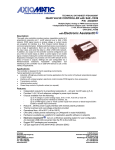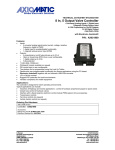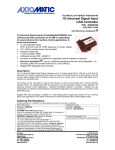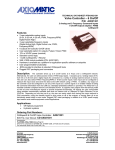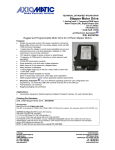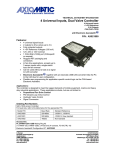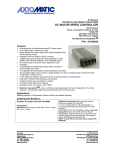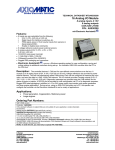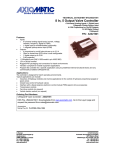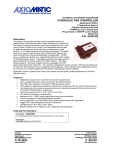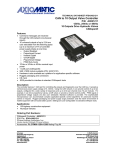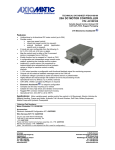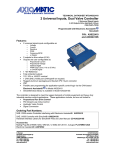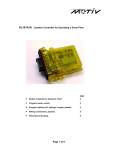Download AX021300
Transcript
TECHNICAL DATASHEET #TDAX021300 Valve Controller – 6 On/Off P/N: AX021300 2 Analog and 3 Frequency Command Inputs 6 On/Off Outputs (Option: PWM) CAN (SAE J1939) with Electronic Assistant® Features: • 2 user selectable analog inputs (0-5V, 0-20 mA, 4-20 mA, PWM, Frequency/RPM, Digital Active High, 16-bit Counter) • 3 user selectable frequency inputs (Digital Active High, Digital Active Low, PWM, Frequency/RPM, 16-bit Counter) • 6 outputs for hydraulic On/Off valves • User selectable option for outputs: Pulsed, Timed, PWM • 12V or 24VDC power (nominal) • Standard control logic • 1 CAN (SAE J1939), 1 RS-232 • CANopen® module available on request (P/N: AX021301) • Hardware is available as a platform for application-specific software or setpoints runs on a Windows operating system for user configuration. An • Electronic Assistant® Axiomatic USB-CAN converter links the PC to the CAN bus. • Rugged IP67 packaging and connectors Description: The controller drives up to 6 on/off valves at 5 Amps over a SAE J1939 network. Alternatively, the user can select pulsed, timed or PWM output types. It accepts up to 2 analog inputs (0-5V, 0-20 mA or 4-20 mA) and 3 digital inputs for connection to a variety of analog machine sensors or levers. The user can also select PWM, Frequency/RPM or 16-bit Counter inputs. Each input can be configured to measure the input value and send the data to a SAE J1939 network. In addition, any output on the controller could be configured to use any of the inputs as a control signal or an enable instead of taking the command information from the CAN bus. Standard embedded software is provided. Settings are user configurable via a Windowsbased Electronic Assistant configuration tool interfacing to the controller via an USB-CAN device. A valuable diagnostic feature involves reading and retaining in the unit’s memory the actual current draw from the solenoid(s). Rugged IP67 rated packaging in addition to a 9-36V power supply input section suits mobile equipment control applications. Applications: • • Off-highway equipment Hydraulic systems Ordering Part Numbers: SAE J1939 version Controller: AX021300 Accessories: PL-DTM06-12SA-12SB Mating Plug Kit (The KIT is comprised of: DTM06-12S, DTM06-12SB, 2 W12S and 24 contacts. The Axiomatic stock # is FG-IOCTRL-19.) AX070502 Configuration KIT includes the following. USB-CAN Converter P/N: AX070501 1 ft. (0.3 m) USB Cable P/N: CBL-USB-AB-MM-1.5 12 in. (30 cm) CAN Cable with female DB-9 P/N: CAB-AX070501 AX070502IN CD P/N: CD-AX070502, includes: Electronic Assistant® software; EA & USB-CAN User Manual UMAX07050X; USB-CAN drivers & documentation; CAN Assistant (Scope and Visual) software & documentation; and the SDK Software Development Kit. NOTE: To order this kit, you need only to specify P/N: AX070502. BLOCK DIAGRAM TDAX021300 2 Technical Specifications: Inputs Power Supply Input - Nominal 12 or 24VDC nominal (9…36 VDC power supply range) Surge protection is provided. Reverse Polarity Protection Analog Inputs Provided 2 inputs (Refer to Table 1.0 and Table 2.0.) Inputs are user selectable with the Windows-based Electronic Assistant. • Analog (0-5V, 0-20mA or 4-20mA) • PWM (up to 5kHz, 0-100% D.C.) • Frequency/RPM (1-65kHz) • 16-bit Counter • Digital (Active High) Analog GND connections are provided. 3 inputs (Refer to Table 1.0 and Table 2.0.) Inputs are user selectable with the Windows-based Electronic Assistant. • Digital (Active High or Active Low) • PWM (up to 5kHz, 0-100% D.C.) • Frequency/RPM (1-65kHz) • 16-bit Counter A digital GND is provided. NB. The max. total current draw on the power supply input pins is 7 A @ 24VDC, at one time. Analog GND Digital Inputs Digital GND Table 1.0 Selection of Inputs to AX021300 Input Type Description # of Inputs There are a total of 5 input channels available, which are user selectable from a variety of input types. There are 5 setpoints per channel associated with the input and how the data is measured. Refer to the user manual for details. Disable Inputs Each input can be configured as a disable input command. When disable is selected, no CAN messages associated with that channel are sent to the network. Analog Inputs Up to 2 analog inputs are available. 0…5VDC The offset is in volts and the resolution setpoint is V/bit, when sending a CAN message. Error detection setpoints are interpreted in volts. 4…20mA or 0…20mA The offset is in milliamps and the resolution setpoint is mA/bit, when sending a message. Error detection setpoints are interpreted in milliamps. Digital Inputs Up to 5 active high, digital inputs is user selectable. Up to 2 active low, digital inputs is user selectable. Active High - The input is configured to read the state of the input (switch is connected to a +V signal when ON). Active Low – The input is configured to read the state of the input (switch is connected to a GND signal when ON). The controller interprets the offset as a state (OFF=0 or ON=1) and the resolution setpoint as state/bit, when sending the message. Error detection setpoints are not used, since error detection is not possible in this mode. PWM Signal Inputs Up to 5 PWM inputs are available to interface to a PWM signal from an ECM, PLC or other. PWM Signal Frequency: up to 6kHz Amplitude: 5-12V PWM Duty Cycle: 0 to 100% The offset is interpreted as percent duty cycle (%dc) and the resolution setpoint as %dc/bit, when sending the CAN message. Error detection setpoints will be interpreted in %dc. Pulse Inputs Up to 5 pulse inputs are available. This input counts the number of pulses over the period of the measuring window setpoint and calculates the frequency of the pulses. Hz = With a pulse per revolution of 0, the controller calculates the offset in Hz and the resolution setpoint as Hz/bit, when sending the CAN message. Error detection setpoints are in Hertz. RPM = With a non-zero pulse per revolution, the frequency is interpreted as a RPM input. The offset is in revolutions per minute (RPM) and the resolution setpoint is RPM/bit. Error detection setpoints are interpreted in RPM. 16-bit Counter Inputs Up to 5 16-bit counter inputs are available. A counter input cannot be used to control an output. The input is configured to count pulses on the input until the value in the measuring window setpoint is reached. While the counter is active, a timer with a 1ms resolution is running in the background. When the count has been reached, the value in the 1ms timer is captured and updated to the input feedback variable. The timer is reset until the count value once again reaches the measuring window. Input and error detection setpoints are not used, since error detection is not possible in this mode. TDAX021300 3 Table 2.0 - Absolute Maximums for Inputs Min Max Units Comments Power Supply 9 36 V dc ¾ ¾ Reverse Polarity and Surge protection is provided. Software, under and over voltage security features. Analog Input Voltage Analog Input Current PWM Input Frequency 0.05 0 50 36 21 6000 Vdc mA Hz ¾ 200 =< Freq <= 1000 Hz recommended for better accuracy PWM duty cycle Input Freq/RPM Input Frequency Digital Input Voltage 0 10 4 100 65000 36 % Hz Vdc Table 3.0 - Input Accuracy Input Type 0 – 5 VDC 0 (4) – 20 mA PWM Frequency / RPM Accuracy +/- 1 % of actual input voltage 100 % +/- 0.1 % duty cycle +/- 0.15 % of actual input frequency Outputs Output Type Digital Output 6 outputs are user selectable from the following. • Digital • Timed • Pulsed • PWM The output response is user selectable from the following. • Disabled • Normal On/Off • Inverted On/Off • Latched There are thirteen setpoints per channel that are associated with the output and how it is controlled and responds to the control signals. High Side (sourcing) Drives up to 6 On/Off Valves (up to 5A each) The output toggles between OFF and ON states based on the states of the enable input/J1939 status byte, the control input/J1939 command message, and the value in the “Response” setpoint. Input State Output State with Normal On/Off Response Output State with Inverted On/Off Response Output State with Latched Response Pulsed Output NB. The maximum total current draw permitted on the power supply input pins is 6 Amps @ 24VDC, at one time. The output toggles between OFF and ON states based on the states of the enable input/J1939 status byte, the control input/J1939 command message, and the value in the “Response” setpoint. However, when the output is ON, the output will be turned on/off at the frequency set in the “Output Frequency” setpoint, with the duty cycle set in the “Pulse Duty Cycle” setpoint. TDAX021300 4 Timed Output The output toggles between OFF and ON states based on the states of the enable input/J1939 status byte, the control input/J1939 command message, and the value in the “Response” setpoint. When a timed output comes ON, the output is turned on after the value in the “Timer Startup Delay” has elapsed. The output will stay on for the time set in “Timer ON Time”, then shut off. If the “Timer Repeat” setpoint is TRUE, then the output will be off for the “Timer OFF Time” before coming back on. The on/off cycle will continue while the output logic state is still ON. The output is switched at the frequency the “Output Frequency” setpoint. The duty cycle is dependent on the values in the “Minimum and Maximum D.C.” as well as the “Minimum and Maximum Input” setpoints. The duty cycle varies linearly with respect to the control input/J1939 command message, as per the graph below. PWM Output PWM OUTPUT PROFILE Duty Cycle ERROR MODE ERROR MODE Maximum Minimum INPUT 0 Minimum Maximum Error Minimum Overcurrent and Short Circuit Protection Output Voltage Regulation Error Maximum Provided 93 % of Supply voltage when all 6 outputs are ON (See Figure 1.0.) Output Volt Percentage vs. Number Of Outputs ON 100.00 99.00 98.00 Percentage [%] 97.00 96.00 95.00 94.00 93.00 92.00 91.00 Output Voltage Percentage 1 2 3 4 5 6 99.33 98.17 97.08 95.92 94.92 93.83 Number of Outputs ON Figure 1.0 - % Output Voltage vs. No. of Outputs ON TDAX021300 5 General Specifications Microprocessor Control Logic Communications CAN Interface DSP56F8346 Standard control logic (Refer to User Manual UMAX021300.) For application-specific control logic, contact Axiomatic. 1 CAN port (SAE J1939) (CANopen® is available on request) 1 RS-232 1 CAN port (SAE J1939) The software was designed to provide flexibility and provides the following. • Configurable ECU Instance in the NAME (for multiple ECU’s on the network) • Configurable Input Parameters • Configurable Output Parameters • Configurable PGN and Data Parameters • Configurable Diagnostic Messaging Parameters, as required • Diagnostic Log, maintained in non-volatile memory Note: Configurable parameters are also called setpoints. Any input or output on the controller by default uses a Proprietary B message to send data to the network bus. There are nine setpoints per channel that are associated with the J1939 message that is sent to the network bus. There are eleven setpoints per channel that are associated with the J1939 command message that is received by the ECU from the network bus. There are five setpoints per channel that are associated with the J1939 feedback message that can be sent by the ECU to the bus. There are six setpoints per input channel, four per output channel, and seven per fault, that are associated with if and how diagnostic messages will be sent to the network bus. To use J1939 capabilities, refer to the user manual. The controller AX021300, is compliant with Bosch CAN protocol specification, Rev.2.0, Part B, and the following J1939 standards. Table 4: J1939 Compliance OSI Network Model Layer J1939 Standard Physical J1939/11 – Physical Layer, 250K bit/s, Twisted Shielded Pair. J1939/15 - Reduced Physical Layer, 250K bits/sec, UnShielded Twisted Pair (UTP). J1939/21 – Data Link Layer Data Link The controller supports Transport Protocol for Diagnostic DM1 and DM2 messages (PGN 65226 and 65227). It supports responses on PGN Requests (PGN 59904) and acknowledgements (PGN 59392). It also supports Proprietary B messaging (PGN 65280 to 65535), and uses a proprietary scheme described in the User Manual. J1939/81 – Network Management J1939, Appendix B – Address and Identity Assignments Network Layer Arbitrary Address Capable ECU - It can dynamically change its network address in real time. The controller supports: Address Claimed Messages (PGN 60928), Requests for Address Claimed Messages (PGN 59904) and Commanded Address Messages (PGN 65240). J1939/71 – Vehicle Application Layer Application Layer None of the application layer PGN’s are supported as part of the default configurations. However, the controller could be configured such that any of the input messages to be sent will use a PGN from this section, or for the outputs to respond to the data in a message with a PGN from this section. The data size, index, resolution and offset can all be configured for the appropriate SPN associated with the PGN. It is the user’s responsibility to configure the controller such that it will not violate the J1939 standard. J1939/73 – Application Layer – Diagnostics TDAX021300 6 The controller can be configured to send “Active Diagnostic Trouble Code” DM1 messages (PGN 65226) for any I/O channel. Warning and Protect diagnostics will automatically become previously active when cleared. “Previously Active Diagnostic Trouble Codes” DM2 messages (PGN 65227) are available on request. Shutdown diagnostics will be cleared upon receiving a “Diagnostic Data Clear/Reset for Active DTC’s” DM11 message (PGN 65235). Occurrence counts in the diagnostic log will be cleared upon receiving a “Diagnostic Data Clear/Reset for Previously Active DTC’s” DM3 message (PGN 65228). User Interface Network Termination Diagnostics Electrical Connections User configuration and diagnostics are provided with the Axiomatic Electronic Assistant®. The Axiomatic Service Tool is a Windows-based graphical user interface that allows easy configuration of the controller setpoints. Refer to Table 5.0 for details. It is necessary to terminate the network with external termination resistors. The resistors are 120 Ohm, 0.25W minimum, metal film or similar type. They are placed between CAN_H and CAN_L terminals at both ends of the network. Current draw from the solenoid(s) is read by the microprocessor and stored in memory. Refer to Table 6.0. Deutsch DTM series 24 pin receptacle (DTM13-12PA-12PB-R008) Mating plug: Deutsch DTM06-12SA and DTM06-12SB with 2 wedgelocks (WM12S) and 24 contacts (1062-20-0122) that accept 18 AWG wire. Use dielectric grease on the pins when installing the controller. Packaging and Dimensions High Temperature Nylon housing - Deutsch IPD PCB Enclosure (EEC-325X4B) 4.62 x 5.24 x 1.43 inches 117.42 x 133.09 x 36.36 mm (W x L x H excluding mating plugs) Weight Operating Conditions Protection 0.55 lbs. (0.25 kg) -40 to 85°C (-40 to 185°F) IP67, Unit is conformally coated in the housing. Plugs carry an IP69 rating. TDAX021300 7 Table 5.0 - AX070500 Electronic Assistant Electronic Assistant® The Electronic Assistant (EA) runs on any modern PC with the Microsoft Windows® 2000 operating system or higher. It comes with a royalty-free license for use. System Requirements: Operating System: Windows 2000 or higher including 64-bit editions Port: USB 1.1 or 2.0 full speed Display: VGA (XGA or better with 1024 x 768 recommended) Setup and Configuration: Refer to the User Manual UMAX07050X. To order the EA software at the time of initial purchase, order the KIT AX070502 (see above) which includes the Axiomatic USB-CAN converter. For additional EA and USB-CAN software ONLY CD’s, use ordering P/N: CDAX070502. Figure 2.0 Configuration screen from the Electronic Assistant The Electronic Assistant® (EA) is a software configuration tool that runs on a PC connected to a J1939 bus via a USB to CAN converter, AX070501. Upon being connected to the bus, the EA will find all the Electronic Control Units (ECU) on the bus, and recognized those manufactured by Axiomatic. Using this tool, a user can quickly configure an Axiomatic ECU for the desired performance over a wide variety of applications. Table 6.0 - Typical Connections, AX021300 Pin # 1 2 3 4 5 6 7 8 9 10 11 12 Grey Connector Function Ground 6 Ground 5 Ground 4 Ground 3 Ground 2 Ground 1 Digital Output 1 Digital Output 2 Digital Output 3 Digital Output 4 Digital Output 5 Digital Output 6 Pin # 1 2 3 4 5 6 7 8 9 10 11 12 Black Connector Function BATT + CAN HI Serial Communication TXD (Not Used) Serial Communication RXD (Not Used) Input 1 (Analog) Input 2 (Analog) Ground Input 5 (Digital) Input 4 (Digital) Input 3 (Digital) CAN LO BATT - Note: CANopen® is a registered community trade mark of CAN in Automation e.V. Specifications are indicative and subject to change. Actual performance will vary depending on the application and operating conditions. Users should satisfy themselves that the product is suitable for use in the intended application. All our products carry a limited warranty against defects in material and workmanship. Please refer to our Warranty, Application Approvals/Limitations and Return Materials Process as described on www.axiomatic.com/service.html. Form: TDAX021300-07/20/09 TDAX021300 8









